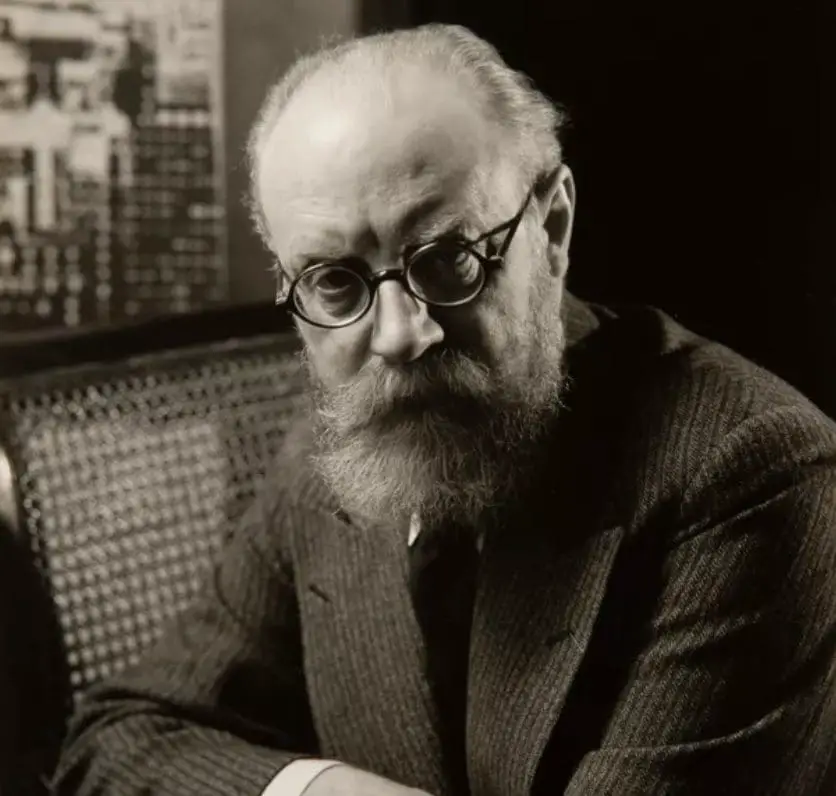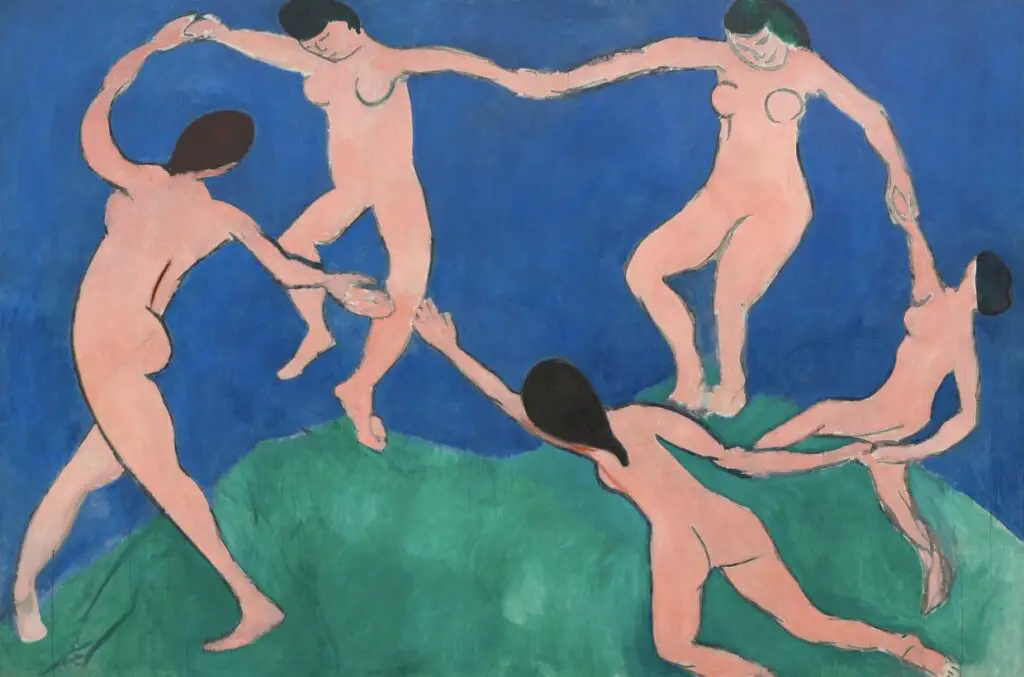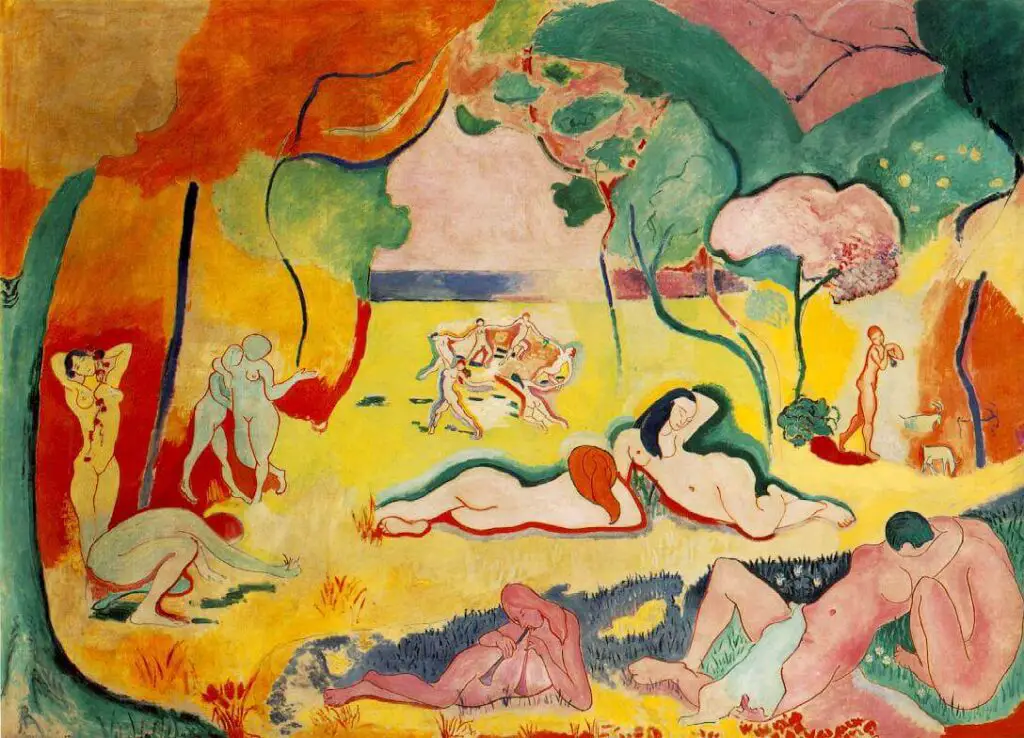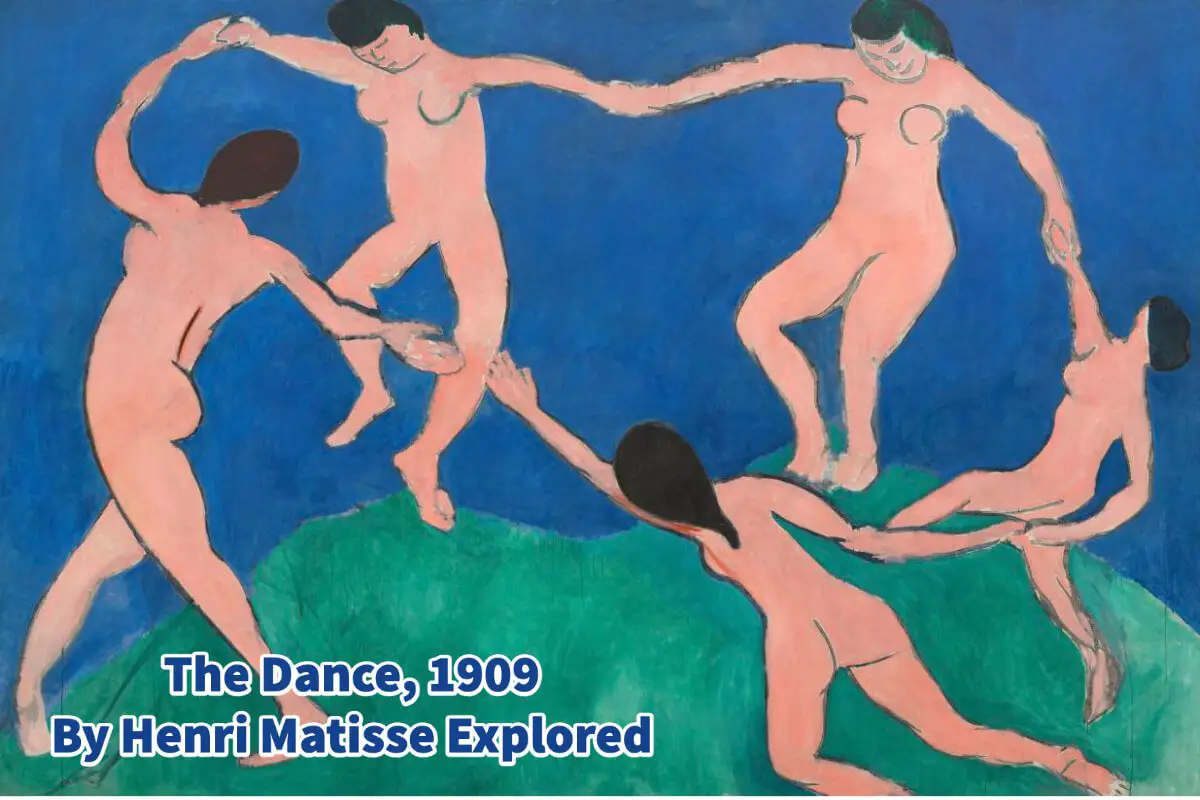Henri Matisse, a renowned figure in Fauvist art, was recognized for his vibrant and expressive creations. His approach to color and form revolutionized the art world, and his impact is still palpable today.
Among his collection of groundbreaking works, “The Dance” is prominent. This iconic piece was initially commissioned and subsequently crafted in 1909. It continues to captivate audiences with its dynamic representation and poignant themes, representing Matisse’s unique artistic vision.
Table of Contents
- About Henri Matisse The Dance, 1909
- The Dance Is A Masterful Piece
- Final Version Of The Dancers 1910
- Related Questions
About Henri Matisse The Dance, 1909

In 1909, Sergei Shchukin, a prosperous Russian industrialist, entrusted the esteemed artist Matisse with a significant task. Shchukin wished Matisse to create three extensive murals to adorn the spiral staircase of his luxurious residence, Trubetskoy Palace, in Moscow.
Dance (I) – A Preliminary Sketch

One of the grand and widely adored pieces, Dance I, found at MoMA, is somewhat misleadingly named. Despite being full-scale and painted in oil, Matisse regarded it as no more than a preliminary sketch. Nevertheless, comparing the first and final versions reveals intriguing insights.
Matisse adapted the theme from the reverse of the 1905-06 piece, Bonheur de Vivre, albeit removing one dancer. In Dance I, the characters depict the light-hearted joy characteristic of the earlier Fauve masterpiece.

The figures are sketched loosely, lacking significant interior details. Their formless and unrestricted movements have been compared to bean bag dolls. However, despite the apparent ease, their bodies are not hindered. Don’t be deceived by the naive spontaneity, though. Matisse strived to make his paintings appear natural and unforced.
Consider, for instance, if Matisse had chosen to present the figures with the rigid intensity of Jacques Louis David instead of employing a childlike style. Would the emotions of pure joy and playful spirit have been conveyed as effectively?
Matisse Abandoned The Rules Of Representation
Matisse accomplished something quite challenging: he abandoned the representation rules to create an image where form aligns with content. The dancers are set against a vibrant backdrop of blue and green.
But what does the green signify? Many might promptly respond, “A grassy hilltop.” If that’s the case, what is the blue supposed to represent?
Upon discussing this at MoMA, some might propose that “the blue is the sky above the hill.” Yet, others might grow restless and contend, “That’s not what I see; the blue signifies water receding into the distance.”
The Dance Is A Masterful Piece
Matisse masterfully uses spatial ambiguity, even in a seemingly straightforward rendering, to investigate a critical concern in modern art – the tension between depth illusion and canvas flatness acknowledgment.
Have you noticed the gap in the circle? The front dancers’ hands are separated. Matisse allowed this split only where it overlays the knee so the color continuity isn’t disrupted.
Why would he do so? The gap is usually interpreted in two ways: as a source of tension that needs resolving or as an invitation for us, the viewers, to participate, especially since the gap is closest to our position.
Final Version Of The Dancers 1910

The final version of The Dance possesses a significantly different emotional feel. It has been termed forbidding, intimidating, tribal, ritualistic, and even demonic.
The once simple joy feels suppressed, as if drum beats could almost be heard. What accounts for these dramatic mood alterations?
Besides the evident color transformation, the 1910 canvas figures are portrayed with more internal lines, often suggesting tension and physical strength. Notice the back left figure, for example.
Another less apparent alteration occurs when the two back figures contact the ground. In the 1909 canvas, the green reaches the feet of the two rearmost dancers. However, in the 1910 canvas, the green appears to shrink under the dancer’s weight.
This subtle change creates a sense of lightness or heaviness, influencing our perception of each painting. Therefore, be cautious before presuming that Matisse was doodling like a child. He was well aware of his intentions.
Additionally, The Dance’s final iteration displays a shift in emotion and atmosphere, stemming from the color scheme and how the figures are depicted. While Dance I portrays an image of innocent, carefree joy.
The Dance seems to echo more profound, perhaps more primal sentiments. The figures in the latter piece exude a certain dynamism and strength that aren’t as pronounced in Dance I.
The back left figure, for instance, carries a certain gravitas that wasn’t present in the earlier rendition. Introducing more defined interior lines accentuates the dancers’ physicality, lending a sense of raw, natural power to the painting. This move and the darker hues imbue the painting with a sense of brooding intensity.
In the first painting, the figures seem to lightly touch the earth as though they are lightly skipping across the landscape. In the second, however, the green appears to recede under the dancers’ weight, creating a different sense of interaction between the figures and the space they occupy. This subtle change, which may go unnoticed, significantly impacts how the painting is perceived.
The changes in The Dance highlight the dancers’ weight and presence and emphasize the painting’s inherent flatness, playing into the larger conversation about the nature of modern painting.
This subtlety is a testament to Matisse’s understanding of his art; even when he depicted his subjects with a certain childlike simplicity, it was a calculated decision that served his artistic vision.
In conclusion, while Matisse’s work might appear simplistic at first glance, the underlying complexities reveal an artist deeply in tune with his craft. His decisions on form, color, and space were never accidental but always served to enhance the expressive qualities of his work. These details make Matisse’s work a joy to study, offering fresh insights with each new viewing.
Anita Louise Art is dedicated to art education, great artists, and inspiring others to find and create their art. We love art that uplifts and inspires. #ArtToMakeYouSmile! #ArtToMakeYouHappy!
If you want to see any of my art, you can find out more by clicking here. If you are interested in what inspires me and my paintings, you can discover more by clicking here.
We have a free newsletter and would love you to be part of our community; you can subscribe to the newsletter by clicking here. I would be happy to talk to you if you have any questions. You can reach me, Anita, by clicking here.
Subscribe to our Anita Louise Art YouTube Channel with great videos and information by clicking here.
Join us for our podcast “5 Minutes With Art.” Spend 5 minutes a week with us to discover and learn about great art and artists. You can find out more about our podcast by clicking here.
Related Questions
What Type Of Artist Is Andy Warhol?
Andy Warhol is a Pop Artist, one of the Pop Art Movement’s major figures. Andy Warhol’s artwork explored the relationship between what is known as the mass popular cultures of his day and art. He used many iconic American objects in his art and painted many celebrities.
By clicking here, you can learn more by reading What Type Of Artist Is Andy Warhol?
Why Did New Art Movements Develop In The Years Following World War 1?
Many art movements after World War 1 came about as a direct protest about the devastation and loss of human life in the First World War. Many of these art movements also included cultural and political movements where like-minded artists band together to produce satirical and other art.
You can discover more by reading Why Did New Art Movements Develop In The Years Following World War 1? by clicking here.
Can Anyone Be An Abstract Artist Without Any Talent In Painting?
To be a great abstract artist, you need talent and an understanding of painting. Painting can be a technical skill artists spend a lifetime perfecting through art education and practice. Great abstract artists have had intensive training in painting, drawing, composition, and color theory.
You can learn more by reading Can Anyone Be An Abstract Artist Without Any Talent In Painting? by clicking here.

